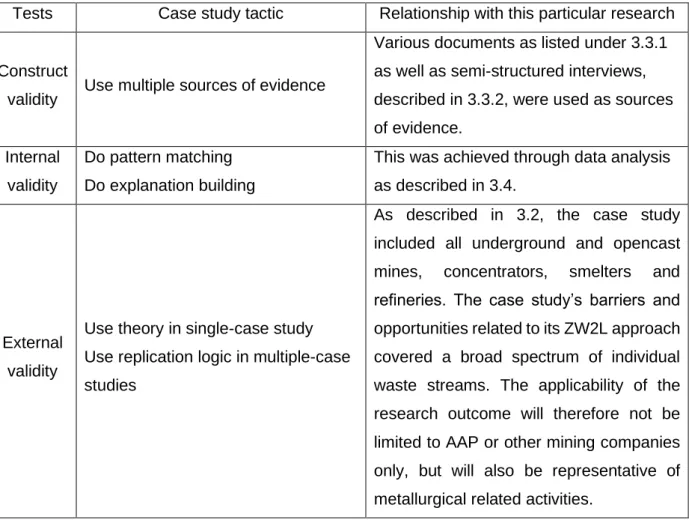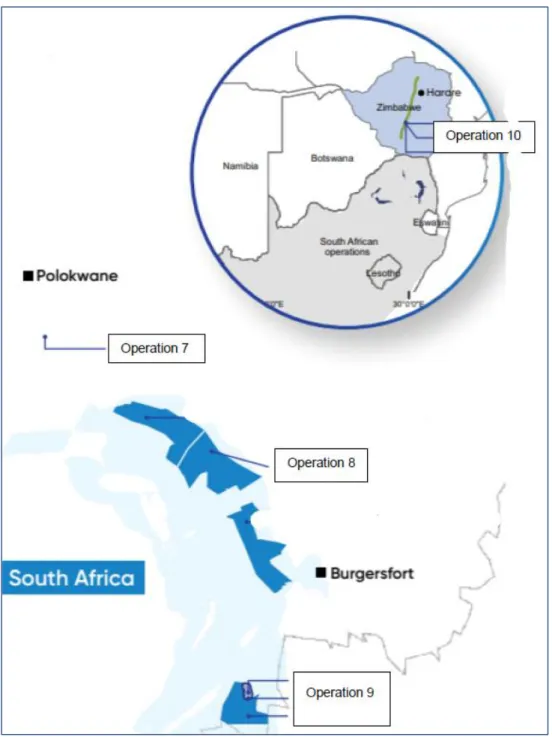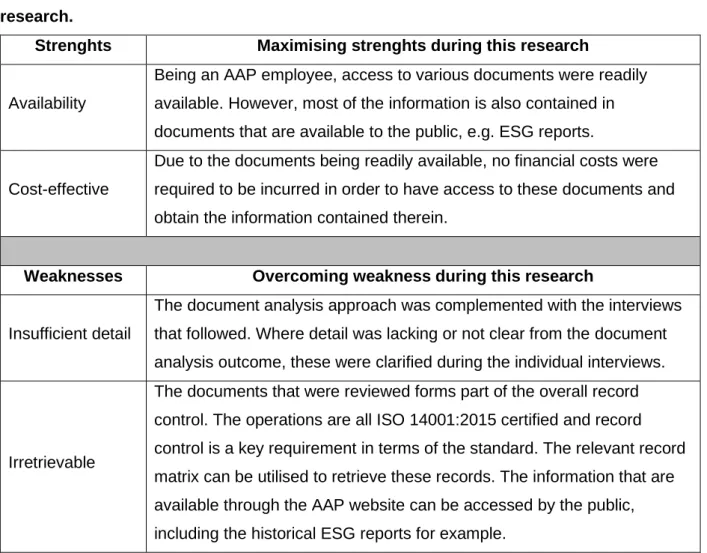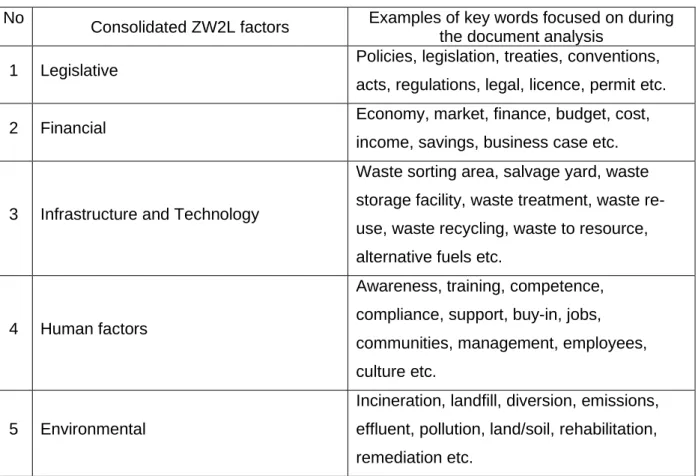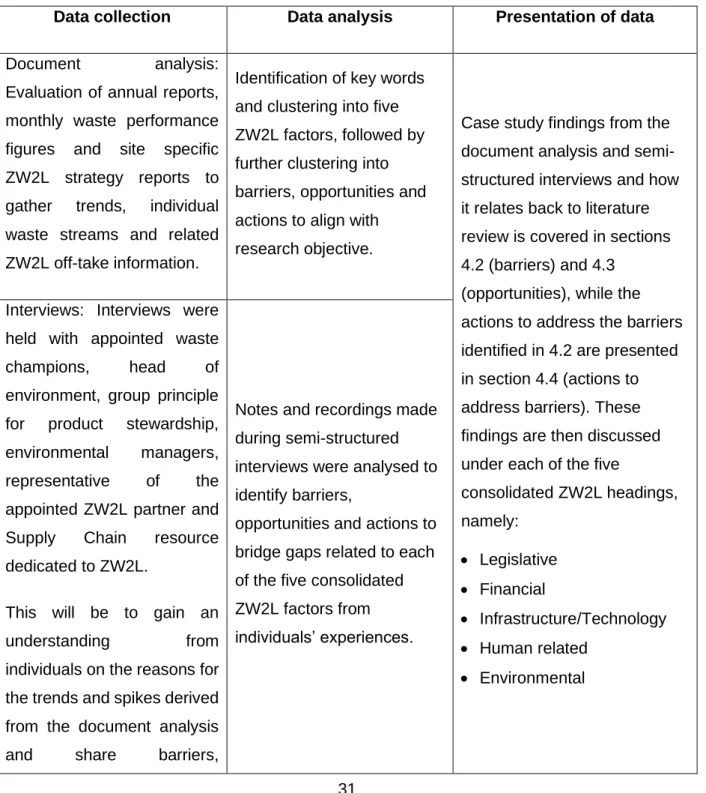The research objective is based on the following question: What barriers and opportunities may affect the implementation of the zero-waste-to-landfills goal in the platinum mining industry. A positive finding from the case study is that gap bridging measures have been identified and successfully implemented to address most of the barriers identified in ZW2L management.
INTRODUCTION
- Background
- Problem statement and rationale for the study
- Research aim and objectives
- Scope of the research
- Structure and outline of the dissertation
In the light of the above statement of the problem, the aim of the research is to determine: what obstacles and opportunities can affect the realization of the goal of zero waste to landfills in the platinum mining industry. The scope of the research focuses on AAP as a case study and includes all its operational facilities, namely: mines, concentrators, smelters and refineries.
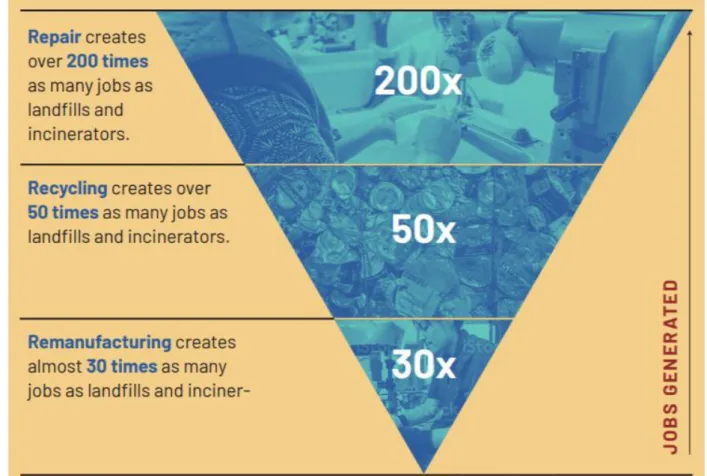
LITERATURE REVIEW
- Introduction
- The ZW2L concept and alignment with the waste management hierarchy
- Frameworks established to support ZW2L through integrated waste
- UN SDG’s supporting the implementation of integrated waste management
- The South African framework approach to support integrated waste
- The Zimbabwean approach to support integrated waste management
- ZW2L approach from a mining perspective
- Barriers in implementing ZW2L
- Legislative barriers
- Financial barriers
- Infrastructure and technological barriers
- Human factor barriers
- Environmental barriers
- Opportunities from the ZW2L implementation
- Financial/economic opportunities
- Community benefit opportunities
- Environmental opportunities
- Bridging the gaps to address ZW2L barriers
- Bridging legislative barriers
- Bridging financial barriers
- Bridging infrastructure and technological barriers
- Bridging human factor barriers
- Bridging environmental barriers
The basis for this mandate is section 24 of the Constitution of South Africa (1996) and the National Environmental Management: Waste Act 59 of 2008 (NEM: WA). This framework consists of the National Development Plan (NDP), Medium Term Strategic Framework (MTSF), Presidential Outcome 10 and the National Waste Management Strategy (NWMS).
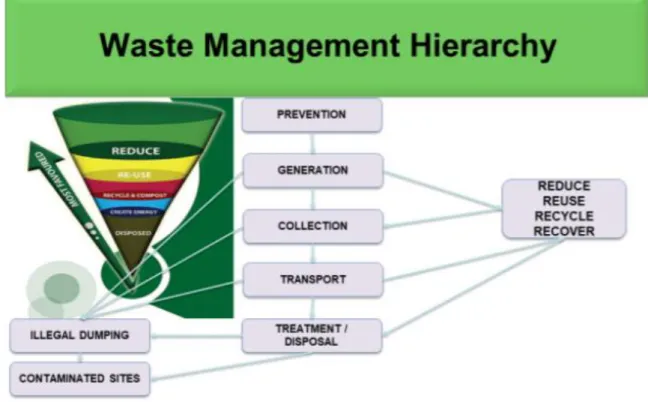
METHODOLOGY
- Introduction
- Research design
- Data collection
- Description of document analysis
- Description of interviews
- Data analysis
- Ethical considerations
- Methodological assumptions and limitations
- Chapter summary
A key step in research design is determining the boundaries of the case to be studied (Yin: 2018). Most of the data is also contained in documents that are accessible to the public, e.g. To counter this caveat, the interviews were limited to participants involved in the ZW2L drive, which provided a baseline knowledge of the overall ZW2L implementation, and the semi-structured interviews provided the added benefit of providing opportunities for detailed discussions of trends and spikes identified during the analysis. document is completed.
During semi-structured interviews, individuals were asked to focus on each of the five consolidated ZW2L factors and indicate whether they experienced each factor as a barrier, an opportunity, a barrier and an opportunity, or none. Interviewees were then asked to indicate what actions had been taken to overcome each of the barriers identified during the semi-structured interview. After the interviews, the notes and tapes were analyzed to reconfirm in which of the five consolidated ZW2L factors the information obtained fit, and to confirm the barriers, opportunities and actions identified.
The results obtained from the analysis of the data collected during document analysis and interviews are discussed in Chapter 4, together with a summary of the comparison of these results with the barriers, opportunities and actions related to the ZW2L factors identified during the literature review in Chapter 2.
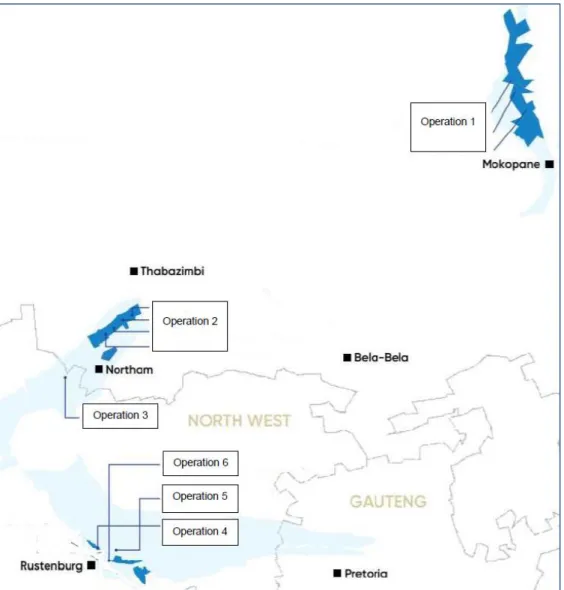
RESULTS AND DISCUSSION
Introduction
ZW2L barriers identified in the case study
- Legislative barriers
- Financial barriers
- Infrastructure and technological barriers
- Human factor barriers
- Environmental impact barriers
The above observations and results from the document analysis and semi-structured interviews are consistent with the observations made in section 2.4.1 of the literature review, with De Jesus & Mendonca (2018:82) stating that as much as legislation plays a role in promoting change, it may also limit the implementation of ZW2L. A clear theme identified during both document analysis and semi-structured interviews was the increased costs associated with the transport, handling and disposal costs of ZW2L discharges versus landfilling, with twelve of the fifteen interviewees highlighting this as an obstacle. Twelve of the fifteen interviewees confirmed that they had experienced infrastructural and technological barriers to achieving ZW2L.
A recurring theme identified from both document analysis and semi-structured interviews is the importance of awareness, with all fifteen individuals interviewed identifying human factors (lack of awareness, leadership, ownership and compliance) as one of the most significant barriers. large of ZW2L. 2020:4) emphasizes that undoubtedly one of the most important barriers of the human factor is the lack of decision-making at the top management level. One of the key observations made during the analysis of the document was that the ZW2L journey appeared to have only started in 2017 instead of 2013 (AAP, 2018).
Only two out of the fifteen interviewees indicated that they experienced environmental impact barriers from the ZW2L drive in the case study.
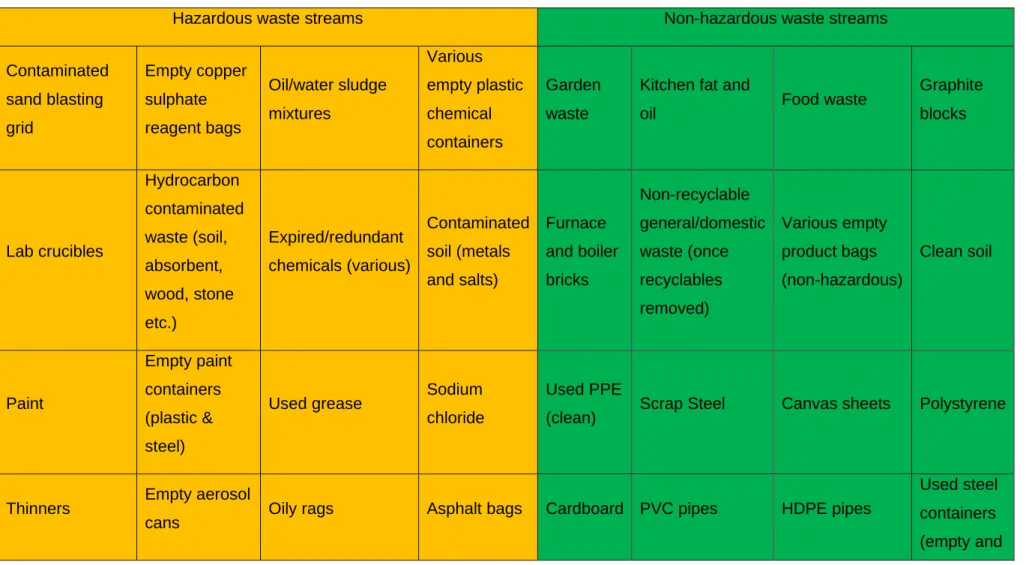
Opportunities identified by the case study in their ZW2L drive
- Legislative opportunities
- Financial opportunities
- Infrastructure and technological opportunities
- Human factor opportunities
- Environmental impact opportunities
These examples identified in the case study are consistent with section 2.5.1 of the literature review which states that the income generated from recycling will contribute to cash flow (Matete and Trois. Another opportunity emerging from trends during the semi-structured interviews identified was that the ZW2L approach acted as a driving force for improving waste management infrastructure to provide for better sorting facilities, roofs to protect recyclables from rain damage, the acquisition of equipment, for example sponsors and compliance with requirements of the national norms and standards From the document analysis carried out, it was identified that one of the strategic pillars around which the case study's ZW2L strategy was developed focused on community benefits.
Members of the local community were also utilized by Operation 10 during the construction of the bioring plants, and full-time jobs were created by appointing attendants from the local communities to operate the incinerator and bioring plant. The above findings are consistent with section 2.5.2 of the literature review, which states that the establishment of mines results in the establishment of businesses to support mining needs and that the opportunity presents itself to also identify entrepreneurs in surrounding communities to uplift them and redress imbalances Nuur et al. This observation was also supported by the result of the semi-structured interviews, where all fifteen interviewees indicated that they experienced opportunities to reduce and eliminate environmental impacts with the case study's ZW2L approach.
The increased recycling and reuse of waste by both the case study and surrounding communities as a result of the awareness created by the ZW2L drive requires less purchase of new products which in turn is associated with less natural and non-renewable resources using are for manufacturing new products.
Actions identified from the case study to address ZW2L barriers
- Addressing legislative barriers
- Addressing financial barriers
- Addressing infrastructure and technological barriers
- Addressing human factor barriers
- Addressing environmental impact barriers
The identification and awareness raising around the positive ZW2L business case also contributed to addressing some of the human factor barriers as discussed in section 4.4.4 (addressing human factor barriers). The actions taken to overcome each of the points discussed in section 4.2.4 (human factor barriers) are detailed below, with the need to create awareness identified as a common theme. Lack of compliance related to at-source sorting, reuse and recycling – The individual operations indicated during the semi-structured interviews that various actions were taken to overcome this barrier by increasing employee and contractor awareness through ZW2L road shows , discussion topics, ZW2L awareness training and updating site-specific induction videos to include ZW2L.
Lack of human resources – The additional sorting requirements to meet the criteria of various ZW2L intakes required the assignment of additional sorters. Failure to identify and understand opportunities associated with solutions ZW2L - Low-grade combustible material was the main waste contributor to landfill quantities in Operation 6. During the semi-structured interview with interviewee 5, it was identified that the environmental manager engaged the GM . the technical team, the on-site environmental team and representatives of the thermal recovery company.
It can be argued that the benchmarking done by the case study not only helped raise awareness, but provided an insight into the international scale of the ZW2L approach.
Chapter summary
This approach will ensure a move in the right direction in relation to the waste management hierarchy and is in line with section 2.6.5 of the literature review, which warns against implementing alternatives that simply shift the environmental impact potential from one sphere of the environment to another (Kerdlap et al) . 2019:16).
CONCLUSIONS AND RECOMMENDATIONS
Introduction
Conclusions
In reviewing the relationship between this case study of platinum mining in South Africa and the findings from the literature review, there is clear evidence of similarities in the barriers, opportunities and actions taken to bridge the gaps in ZW2L management. Surprisingly the only area where the findings of the literature review differ from the evidence gathered from this case study is the availability of technology as described in section 4.2.3. While the literature review (Godfrey & . Oelofse, 2017:6) provided arguments for the lack of transport and available technology, the evidence gathered from this platinum mine case study did not show any transport-related barriers contributing to technological barriers and that ZW2L technologies were available for most waste streams in the South African mining context.
Although the ZW2L opportunities in the literature review were limited to environmental, financial and human factors, document analysis and semi-structured interviews in the platinum mining case study identified opportunities related to more than just financial, environmental and social factors. factors, but also technological and legislative opportunities. Another interesting observation, as described in section 4.4.4, is that the literature review (Gjetley and Pierre identified benchmarking with other industries as a way to bridge gaps related to infrastructure and technological barriers, while it became clear from the case study of platinum mining that benchmarking has been identified as a valuable means of addressing human factor barriers From a literature review Singh et al 2020:2 acknowledge that although there is literature available that addresses barriers to the adoption of circular business models, the availability of literature is limited with special reference to the perspective of the mining industry.
This is further supported by the congruence between the factors identified from the literature review and this particular case study and therefore it can be argued that the barriers, opportunities and actions taken to bridge the gaps in driving ZW2L will be applicable to mining in general on a global scale where location is ultimately the deciding factor between a factor identified as a barrier versus an opportunity.
Recommendations and areas of future research
Group/Platinum/investors/annual-reporting/2021/aap-ore-reserves-and-mineral-resources-report-2020.pdf Date accessed: 4 May 2021. National Environmental Management: Waste Act, 2008 (Act 59 of 2008 ): National Norms and Standards for Landfill Disposal (Notice 636). A systematic review of drivers, barriers and practices towards a circular economy: a supply chain perspective, International Journal of Production Research, p. Unpublished report prepared for AAP).
Zero Waste Manufacturing: A Framework and Review of Technology, Research and Implementation Barriers to Enabling a Circular Economy Transition in Singapore, Resources, Conservation and Recycling, 104438. Operations Management for the Circular Economy in the Mining Sector: An Analysis of barrier intensity, Policy Resources, 101752. Update on waste management for Anglo American Platinum preserved Rustenburg process [email communication memo]. August 16.

